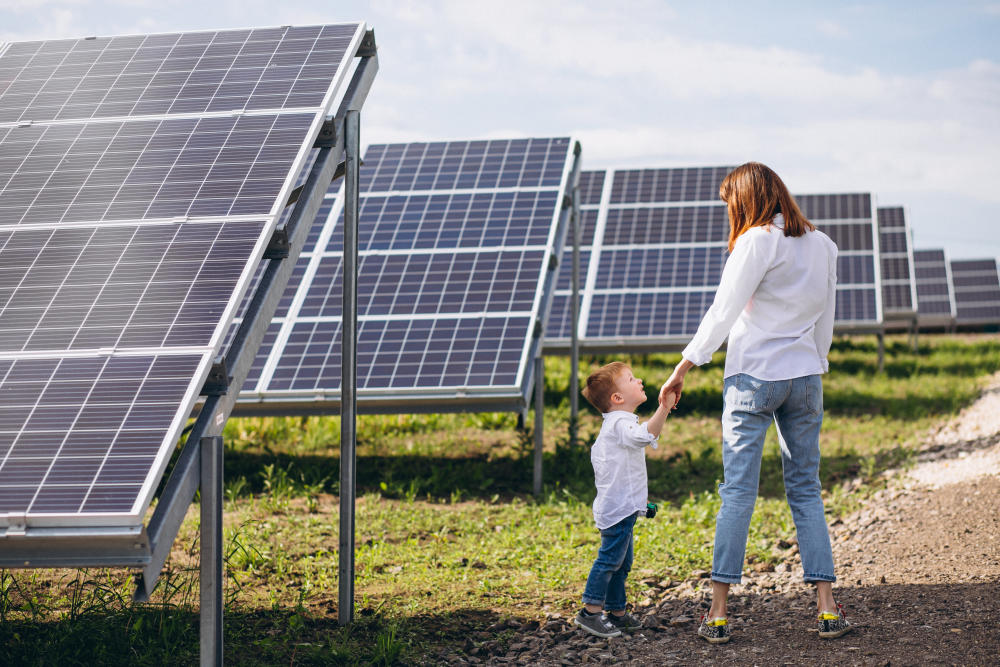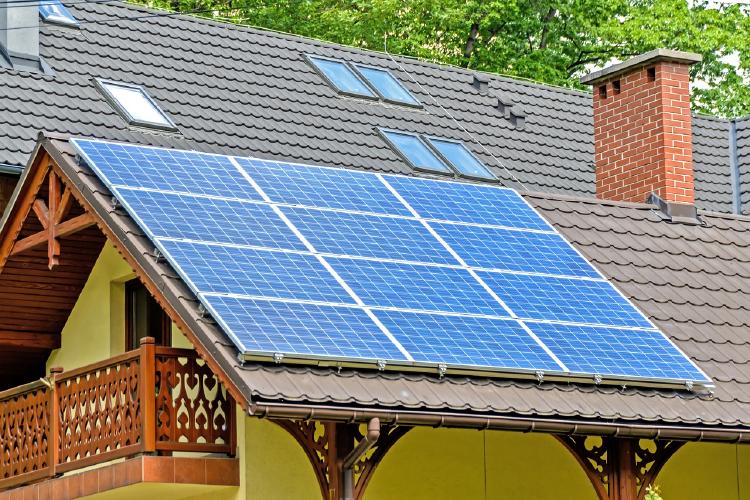
Solar energy is an example of a secondary energy source. Leaving behind the use of fossil fuels or “dirty energy” and turning to renewables or “clean energy” should be on every country’s agenda. Learn what solar energy is and its importance for a greener future and start considering going for a clean change in energy consumption. Let's dive into: "What Solar Energy Is and Its Importance For a Greener Future".
Renewable energy is obtained from natural resources and it is the alternative to ultimately help lowering emissions of carbon and other types of pollution. Examples of renewables are wind and solar energy. Leaving behind the use of fossil fuels or “dirty energy” and turning to renewables or “clean energy” should be on every country’s agenda.
When defining what solar energy is, we have to think of the sun as our best partner for an eco-friendly life. And that’s right, solar power can change the future in terms of consumption and sustainability. The amount of sunlight the Earth gets in an hour and a half can be enough to satisfy the demands of the whole world energy needs for a year. But, then, how is solar energy stored? There are different ways of capturing and storing solar energy and you can think of this option for your house and business.
To answer what solar energy is, we immediately think of the sun being our main source of light and heat. That 's right. The Sun works as a nuclear reactor on the space, liberating photons, each particle of sunlight loaded with energy produced in the core of the Sun, which are then radiated outwards as sun rays hitting on Earth.

To have a better idea of what solar energy is and its environmental importance, we should first understand how we can benefit from it. Solar energy refers to the electricity obtained from sunlight when it hits on our planet.
Light and heat from the Sun is harnessed by the use of photovoltaic panels. Other solar technologies include solar water heating/cooling, solar electricity and passive solar. Apart from being clean, solar energy is the most renewable energy source we have on earth. It’s a great alternative to fossil fuels and might be the solution for a greener future.
To understand the process, we should first understand what solar energy is, how solar energy is captured and how it’s used to provide electricity. There are two main ways to harness solar energy: photovoltaics and solar heating/cooling.
Photovoltaic is the process through which the sun’s rays are converted into electricity, called photovoltaic effect. Simply put, we get energy by the use of solar panels. These are metal layers that capture heat from rays and turn it into electricity or store it for later use. Every panel is made of photovoltaic cells (typically made of silicon) that absorb energy from sunlight and produce electrical charges that spread in response to an electrical field in the cell thus making electricity to flow.
Solar heating and cooling (SHC) technologies, on the other hand, use solar heating collectors for heating and cooling spaces. SHC systems use the sun’s radiation to heat water running in the home’s piping thus warming our house. Heat can also be used to cool our homes. By the combination of solar thermal energy and adsorption technology we can use heat to cool our homes thanks to thermal processes driven by the sun and thus producing coldness for air-conditioning aims.
What’s more, solar energy is also used to heat homes and spaces through passive solar heating. Passive solar heating is the technique of building properties using thermal materials which absorb the sunlight and heat the spaces when there isn’t sunlight or designing spaces strategically to take advantage of the sun’s rays, using south-facing glass.

Solar panels are a great option to capture energy from the sun. Now, what happens when the sun is not shining? Then, collecting and storing for later use is the best we can do.
During periods of low solar production, solar batteries are our best alternative. When we store all the energy received from the sun during the day, all the surplus power is used during peak-use, that is, at night. This energy reservoir is charged during high intense sunlight peaks and then is ready to use during the night resulting in a perfect and convenient system to balance energy loads.
The most preferred ways to store energy are thermal and battery. Thermal energy storage absorbs and retains the sun’s heat through water or molten salt. This is kept in an insulated tank until the energy is needed to boil water to produce energy, mainly, either at night or on cloudy days.
Solar energy can also be kept in electrochemical batteries. In the case of photovoltaic energy, as solar panels don’t produce energy at night, rechargeable batteries come in handy in these cases. Solar panels charge the battery during the day so as to have energy available at night. As for thermal energy, hot water is stored in a storage tank to be used when needed.
Here are some options to have a Sustainable Home: Solar Panels: How to Incorporate them into your House
What’s solar energy and storage? The perfect combination to go totally solar is having panels and batteries. Your panel collects the heat and feeds energy to an inverter, that energy switches all the appliances at home. At night or on cloudy days, all the surplus energy stored in the solar battery will power all your house.
Bear in mind that most residences with solar energy systems are connected to electricity grids. When your panels produce more energy than you need, that surplus goes back to the power grid. In the same way, when your home requires more electricity than your solar panel is generating, then you can make use of the power from the electrical grid.
Now that you know what solar energy is ,plus its several benefits, and how solar energy is stored, it’s time to plan ahead and begin the transition.
Solar panels can be installed anywhere no matter the weather conditions you have on your location.Actually, panels still work without sunlight because radiation penetrates through the clouds as well. However, keep in mind that there are some points to consider before beginning the process of going solar.
To start with, you should look for companies in your area to help you determine your choices available. It’s important to consider the type of roof and the materials, and the surroundings in your residence: having too many trees around won’t allow the sun to reach the panels. In case your rooftop is not suitable for solar panels, you can opt for community solar which allows several people to use the same solar array on or off site to get solar energy. You can decide on the budget altogether and have access to clean energy with solar panels no matter the roof you have.
Remember you can also choose to have a SHC system to heat and cool your house which is also a green option in solar technologies. Also, if you’re planning to build your own house, you might consider passive solar design building, choosing the materials and building’s site to take advantage of the sun’s energy to cool and heat spaces.

Start fighting the climate crisis and stop being dependent on fossil fuels. Advantages truly outweigh the drawbacks you might find when going solar. Let’s see some facts to take into account about solar technologies:
For sure, the first change you will notice when you start using solar energy is an important drop in your electricity bill. Also, there is a chance you even get payment for the unused energy that goes back to the grid. Some governments offer federal tax credits for small-scale low-carbon energy technologies.
First, think about what solar energy is for climate change. What’s solar energy’s importance in carbon footprint reduction?
Consider that solar energy is a renewable natural energy source, that means not relying on fossil fuels anymore. It’s a huge step in the reduction of the carbon footprint. A regular solar panel can eliminate around three to four tons of carbon emissions per year which equals planting a hundred trees.
For more about carbon footprint, you can't miss this article: Carbon Footprint: What This Is and What We Can Do about It
There can be a considerable initial cost when you decide to go solar. However, once you have your solar panel installed, it will only require cleaning three times a year. Cleaning companies have really competitive prices so you can keep on your budget.
As for the panel itself, it is good to know that they have a 20-25 years warranty. So you have clean energy for a great amount of time, with almost zero cost or little spending on maintenance.
Having a solar energy system for the first time means thinking about investing in panels, inverters, batteries, wiring and installation, and that can be expensive. However, even more and more people are choosing this renewable energy source option so prices may ultimately go down in the near future.
Remember that though solar panels still collect sunlight when it’s cloudy, their efficiency is reduced. So, weather conditions do have an impact on the quantity of solar power you can get.
Ever wonder what solar energy is like when the sun isn’t shining? Well, think about how solar energy is stored. Panels depend on sunlight. During the night, you have to rely on the energy grid. Yet, you can make use of the energy stored in solar batteries. This is a practical solution as they are charged during the day; however, they are usually quite expensive.
Now you’ve learned how solar energy works and how valuable it is to make a change to stop using “dirty energy”, it’s time to take action. Whether you are planning to build your own “solar house” or you just want to be part of a green revolution, going solar is a great step you can make.
Solar energy systems are inexpensive. The solar energy is the most renewable source we have on the planet, it's everywhere. We are never going to run out of sunlight, right? You’ve even learned how solar energy is stored using batteries. So it’s high time we all take advantage of this natural resource and stop using fossil fuels. Choosing photovoltaic panels, SHC systems or passive solar technologies, they will all have an impact on the reduction of the carbon footprint. So, start investing now and enjoy a greener future.
SUN 'S GREAT, EH? 🌞
You may be interested at: Climate Crisis Books: What You Must Read to Know What's happening